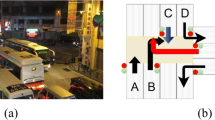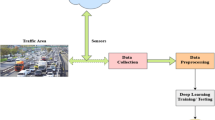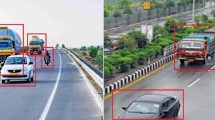Abstract
Traffic congestion increases day by day because of the number of vehicles, lack of traffic control, and the limitations of the technologies being deployed. People in big cities suffer from this issue and look for a permanent solution. This congestion causes air pollution, noise pollution, and may lead to a catastrophic situation. In big cities with large populations, traffic congestion happens daily and affects the quality of air. Various projects have been placed to resolve this issue; however, it remains unresolved, and drivers get totally annoyed. Numerous technologies, such as IoTs and deep learning are widely applied recently due to their results and costs. In this article, a novel Intelligent Adaptive Traffic Control and Management System (IATCMS) based on a deep-learning architecture and IoTs is proposed. This system utilizes Wireless sensor networks (WSNs), cameras, a Database, a Central Control Unit (CCU), and a newly developed Generative Adversarial Network (NDGAN). This approach aims to reduce congestion, provide air quality, reduce fuel consumption, control traffic, and save lives in case of accidents by letting ambulances reach destinations quickly. In addition, the method ensures smooth traffic with a reasonable speed. Various key factors, such as speed of vehicles, traffic density, length of roads, and allocated light signal times are considered to provide a feasible solution to remove or reduce congestion and minimize traffic waiting time at intersections. This algorithm determines which lane gets the highest priority to proceed first by computing the traffic density for each road and gives the lane with the highest density priority. The presented model is tested and analyzed in MATLAB. The approach reduces the average waiting time at intersections by nearly 34% to 48% and removes congestion in some scenarios. The achieved results indicate that the proposed system can be applied at any intersection around the world to provide a smooth trip and remove traffic congestion.







Similar content being viewed by others
Data availability
The data used in this article were collected by the authors from the mentioned road.
References
Chahal A, Gulia P, Gill NS, Priyadarshini I (2023) A Hybrid Univariate Traffic Congestion Prediction Model for IoT-Enabled Smart City. Information 14(268):1–19
Anjum M, Shahab S, Dimitrakopoulos G, Guye HF (2023) An In-Vehicle Behaviour-Based Response Model for Traffic Monitoring and Driving Assistance in the Context of Smart Cities. Electronics 12(1644):1–19
Abdullah SM, Periyasamy M, Kamaludeen NA, Towfek SK, Marappan R, Raju SK, Alharbi AH, Khafaga DS (2023) Optimizing Traffic Flow in Smart Cities: Soft GRU-Based Recurrent Neural Networks for Enhanced Congestion Prediction Using Deep Learning. Sustainability 15(5949):1–21
Sun C, Liu F (2021) Simulation and Research of Urban Intelligent Traffic Light Control System. J Phys Conf Ser AMMS 2068:1–6
Prakash P, Singh A, Parasrampuria A, Sharma G (2021) An IOT based Smart Traffic Management System. Int J Electr Electron Comput 6(5):6–11
Prasad R, Yadav H, Kumar D, Pandey S, Yadav A (2021) Smart Traffic Monitoring and Controlling. Journal of Emerging Technologies and Innovative Research 8(6):f744–f748
Miyim AM, Muhammed MA (2019) Smart traffic management system. In: 15th International conference on electronics computer and computation, Abuja, Nigeria, pp 1–7
Ponnle A, Udekwe C (2019) Automated traffic light system for two inter-dependent road intersections: a case study of oloko and road block/orita-obele junctions in Akure, Nigeria. In: Proceedings of the 2019 Annual Conference of the School of Engineering and Engineering Technology, pp 815–838
Almawgani AHM (2018) Design of real time smart traffic light control system. Int J Ind Electron Electr Eng 6(4):43–47
Chandan KK, Sundaram SM, D’sa C, Swamy MN, Navya K (2017) A Smart Traffic Management System for Congestion Control and Warnings Using Internet of Things (IoT). Saudi J Eng Technol 2(5):192–196
Yawle RU, Modak KK, Shivshette PS, Vhaval SS (2016) Smart Traffic Control System. SSRG Int J Electron Commun Eng 3(3):20–23
Omina JA (2015) An Intelligent Traffic Light Control System Based on Fuzzy Logic Algorithm. Int Acad J Inf Syst Technol 1(5):1–17
Gupta P, Gadre VD, Rawat TK (2014) Real Time Traffic Light Control System (Hardware and Software Implementation). Int J Electron Electr Eng 7(5):505–510
Mohamed SAE, Alshalfan KA (2021) Intelligent traffic management system based on the internet of vehicles (IoV). J Adv Transp 4037533:23
Joo H, Lim Y (2021) Traffic signal time optimization based on deep Q-network. Appl Sci 11(21):1–14
Acknowledgements
The authors extend their appreciation to the Deanship of Scientific Research at Northern Border University, Arar, KSA for funding this research work through the project number “NBU-FFR-2023-0033”.
Funding
This work was funded by the Deanship of Scientific Research at Northern Border University, Arar, KSA through the project number “NBU-FFR-2023-0033”.
Author information
Authors and Affiliations
Corresponding author
Ethics declarations
Conflicts of interest
The authors declare they have no conflicts of interest to report regarding the present study.
Additional information
Publisher's note
Springer Nature remains neutral with regard to jurisdictional claims in published maps and institutional affiliations.
Rights and permissions
Springer Nature or its licensor (e.g. a society or other partner) holds exclusive rights to this article under a publishing agreement with the author(s) or other rightsholder(s); author self-archiving of the accepted manuscript version of this article is solely governed by the terms of such publishing agreement and applicable law.
About this article
Cite this article
Alsheikhy, A.A., Said, Y.F. & Shawly, T. A novel intelligent smart traffic system using a deep-learning architecture. Multimed Tools Appl 83, 37913–37926 (2024). https://doi.org/10.1007/s11042-023-17003-3
Received:
Revised:
Accepted:
Published:
Issue Date:
DOI: https://doi.org/10.1007/s11042-023-17003-3




